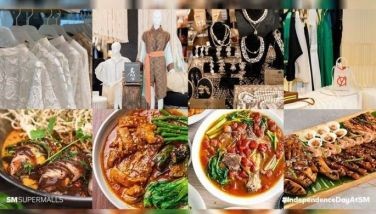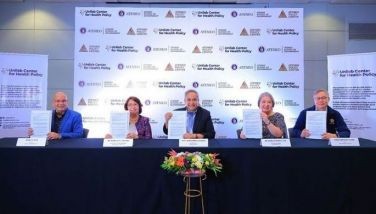Military might
Men in uniform have played a vital role in history and the influence has been translated into fashion. Military appeal is so mighty that civilian fashion has utilized every single detail of the uniform, from epaulets to ball buttons, field jackets, anoraks, khakis, bomber jackets, aviator shades, navy blue, sailors’ drop-front bell-bottom trousers, pea coats, and commandos’ knit sweaters. This season, military has staged yet another coup d’état.
Diana Vreeland, the iconic American fashion editor of the late 20th century, called uniforms “the sportswear of the 19th century.” Burberry’s iconic trench coat was originally made for the Boer war and World War I officers. The protective coat with latched wrist and collar has now become a civilian wardrobe basic. The waist-cropped field jacket (M-1944), popularly known as the Eisenhower jacket, and the multi-environment combat M-43 field jacket have inspired countless fashion incarnations.
As women changed roles in American society and the military, so did the uniforms. In World War I they wore street uniforms worn with straw or felt hats. Army and navy nurses wore blue, while female marines wore forest green. Mainbocher designed sailor hats for the Navy WAVES (Women Accepted for Volunteer Emergency Service) and Coast Guard SPARS. Women Marines matched Montezuma-red lipstick to the cords attached to their forest-green service caps. Then uniforms became even more fashionable with Christian Dior’s New Look, a calf-length skirt. In 1951, designer Hattie Carnegie designed a taupe army uniform and Mainbocher updated the Marine ensemble.
 Not only fashion has experienced the shift from function to fancy but also the military uniform. What used to be functional military details are now used as embellishments. Take, for instance, the braid, which was a feature to deflect sword blades from the chest, and later became a hierarchal symbol. The now-decorative ball buttons were originally attached to the uniform as backup ammunition during battle. Plastrons, or double-breasted-chests, served as added protection for the heart and sashes used to carry the wounded from the battlefield. The primarily practical details became a part of military pomp and circumstance. Tradition has remained a constant in military uniforms, but the continuous changes in missions, cost, efficiency, comfort and materials have consequently driven an evolution.
Not only fashion has experienced the shift from function to fancy but also the military uniform. What used to be functional military details are now used as embellishments. Take, for instance, the braid, which was a feature to deflect sword blades from the chest, and later became a hierarchal symbol. The now-decorative ball buttons were originally attached to the uniform as backup ammunition during battle. Plastrons, or double-breasted-chests, served as added protection for the heart and sashes used to carry the wounded from the battlefield. The primarily practical details became a part of military pomp and circumstance. Tradition has remained a constant in military uniforms, but the continuous changes in missions, cost, efficiency, comfort and materials have consequently driven an evolution.
Blue was the color of choice for the US army, red for the British and white for the French during the Continental war. Sky blue trousers replaced white to better conceal winter mud. By 1851, branch colors were added to the French full-skirt frock coat. Blue was still the dominant choice in the US civil war for the Union forces, while the Confederates wore gray. Gray has been the economical color of state units and West Point since 1816. The Union army’s blue sack-coat fatigue blouse and French cap were utilized as postwar duty-wear. The need for seasonal service uniforms and better cover-up from rapid fire paved the way for field uniforms in cotton khaki and olive wool. Army blue became limited to dress uniforms. GIs had the M-1 helmet and liner, cargo pocket fatigues, parachute jumper, combat boots and field jacket in World War II.
In the late ’50s, army green replaced olive drab and seasonal khaki lasted until the mid-’80s. The navy’s dark blue and summer-white sailor suits have also become fashion staples. An alternative to the trench, the Dutch pea coat, historically a navy overcoat, has crossed over into public life as well. World War II blue denim and chambray dungarees for working seamen and bell-bottom trousers with buttons have seen multiple representations in fashion. Camouflage, designed to blend with a landscape of heat and dust courtesy of the British, has also made its way into urban fashion. And who hasn’t coveted an updated World War II bomber jacket originally worn by air force pilots?
 The season’s obsession with the utilitarian trend featured a selection of looks fit for any lifestyle. Enlist and get into the style siege:
The season’s obsession with the utilitarian trend featured a selection of looks fit for any lifestyle. Enlist and get into the style siege:
• Key to the season’s look: Don’t be literal. Pair with feminine pieces to play up the contrast of hard and soft.
• Invest in a military jacket you can throw over everything, from evening garb to denim shorts. It’s one of those things that goes with everything.
• Khakis and olives can replace your basic black.
• Add a pair of utility or cargo pants to your wardrobe.
• Choose fitted shirts and jackets for an updated look.
• Stylize the jacket by cinching it with a belt.
• A military must and also a wardrobe staple: a white tank.
• Be eco-friendly. Take the military’s cue and use handkerchiefs instead.
• Get the detail with military accoutrements, from fancy frogging to braids, ball buttons, grommets and garrison belts.
• Invest in a military watch. It’s hip and functional. This is one investment that will surely stand the test of time.
• Imbibe the military way. Discipline is key. Live well. Stay fit. Eat healthy.
• Always look polished and put-together.
 I am an army brat and proud of it. My love for all things military is deeply rooted. I was exposed to it at such a young age. My father lived and breathed it. He graduated from the Philippine Military Academy in 1961 and devoted his life to the service until his untimely death in 1993. He taught in the academy in his early years then served in the field for most of his military career. I saw his various uniforms, from his service wear to his field uniform. I would watch in awe when he would prepare to dress. Khakis well pressed, check. Brass details polished, check. Shoes shined, check. Hair groomed, not one hair out of place, check. Hanky in pocket, check.
I am an army brat and proud of it. My love for all things military is deeply rooted. I was exposed to it at such a young age. My father lived and breathed it. He graduated from the Philippine Military Academy in 1961 and devoted his life to the service until his untimely death in 1993. He taught in the academy in his early years then served in the field for most of his military career. I saw his various uniforms, from his service wear to his field uniform. I would watch in awe when he would prepare to dress. Khakis well pressed, check. Brass details polished, check. Shoes shined, check. Hair groomed, not one hair out of place, check. Hanky in pocket, check.
I admired this discipline. I admired him so that I wanted to follow his footsteps. At that time, women in the military were not as prevalent as they are now, so he was the first one to discourage me. So I was just too happy to channel my frustration to the relentless military takeover in fashion. As soon as I was big enough to fit into my father’s old khakis, which my sister Ces updated to Bermuda shorts, I could not wear enough of it. I would use my father’s old brass buttons to embellish my custom-made safari jacket. I added my father’s class ring as a charm on my necklace. I have also collected vintage uniforms through the years. I have continued to use them and just spruce them up with modern accessories.
A sneak peek at next season’s collections reveals a continuing preoccupation with military references. These reliable pieces will march through to the next season. A resounding need for classical and functional pieces has given the military influence staying power. So, march to the military beat and start collecting your basic keepers.
* * *
Send queries and suggestions to jo@joyceorena.com.




















